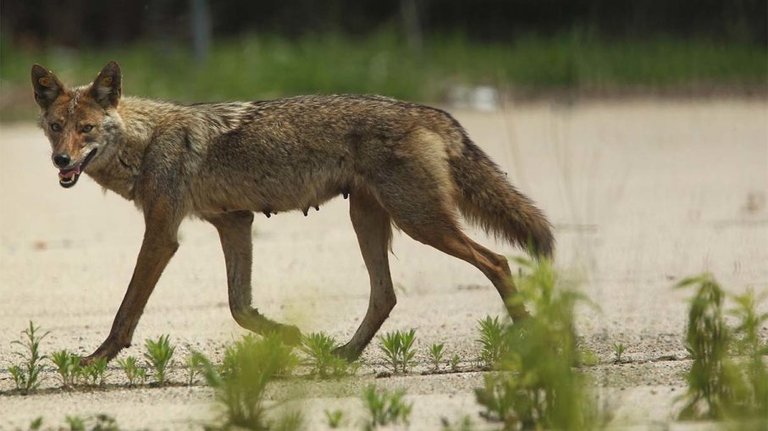
A mother coyote traverses a vacant lot in Chicago.
We already know coyotes are wily. But did you know that they are monogamous and mate for life? Turns out that their propensity toward long-term commitment is what gives them a competitive advantage for survival. The abundance of food sources in urban areas allows the mama coyote to produce large litters, while the dedication of her faithful mate, a coequal and constant partner in pup-rearing, ensures a high survival rate. These crafty Canis latrans have managed to expand their habitat from origins in the American Southwest to a ubiquitous presence in rural, suburban and urban environments throughout the entire continental United States — even densely populated cities like Atlanta, Chicago, New York and San Francisco.
Urban coyotes have a fierce and formidable reputation as midnight predators that stalk and kill our beloved pets, especially small dogs and outdoor cats. Coyotes will attack household pets, but the numbers are difficult to pin down because it's hard to prove a coyote attack occurred based on injuries alone. While occasional tragic and horrific coyote attacks on pets do occur, the truth is, coyotes are by nature shy, human-avoiding and, for the most part omnivorous, crepuscular creatures whose preferred diet includes rodents, rabbits and squirrels, insects, snakes and berries, roadkill and discarded human refuse like Big Macs and fries.
In large cities, they often dodge detection by becoming strictly nocturnal, holing up during the day in out-of-the-way parking garages, alleys, underpasses, drainage ditches, old pipes and other quiet secluded hideaways. However, it is not necessarily unusual to spot a coyote sunning in the open space of, say, a public park, or loping across a golf course during the day, where squirrels and other small diurnal food sources are active. And a daytime sighting doesn't mean that a coyote is sick or rabid.
Masters of adaptation, suburban and urban coyotes alike have managed to thrive in large part by capitalizing on the human destruction of surrounding natural landscapes. Ongoing development of sprawling subdivisionsand big box business complexes continues to encroach upon what once was free-range wildlife habitat bordering major metropolitan areas. The loss of these green, wooded spaces means the loss of food, water and shelter for all kinds of animals, and has pushed coyotes into ever-closer contact with people and their pets. Breeding season, from January to March, is the most common time for potentially negative encounters between coyotes and people. And it is also the time when coyotes are the hungriest and most aggressive.
Some Helpful Tips
Keeping in mind that coyotes are for the most part as afraid of us as we are of them, here are some helpful and potentially life-saving tips to keep ourselves and our pets safe as we try to understand and coexist with the elusive and tenacious urban coyote. Taking precautions with food, both human and animal, is foremost:
- NEVER intentionally feed a coyote.
- NEVER keep pet food outside.
- Always clean your grill after using and store it in a garage or shed if possible.
- Securely cover your trash and recycling cans. Put your trash out the morning of pick-up.
- Make sure your compost bin is securely covered. Never add meat waste to compost.
- Pick up fallen fruit from fruit trees. Don't let it rot on the ground.
Some commonsense safety tips for your pets:
- Keep cats indoors. At the very least, keep them inside between dusk and dawn.
- Don't leave dogs of any size tied up outside — defenseless, they are no match for a coyote.
- NEVER let your dog outside unattended, even in a fenced yard.
If you see a coyote in your yard or neighborhood, ALWAYS haze them away. Yell. Clap. Stomp your feet. Wave your arms. Throw rocks or tennis balls in the coyote's general direction, not to hit, but to frighten. Spray them with a garden hose. NEVER become indifferent to hazing or the coyote could lose its natural fear and become habituated. Encourage your friends and neighbors never to become complacent about hazing.
And consider some of the following hardware (there's always hardware, isn't there?):
- Install motion-sensing lights to scare coyotes off at night.
- Consider installing rollers on fences; make sure fences are at least 6 feet (1.83 meters) tall.
- Consider the Coyote Vest for your small dog.
Be super vigilant if you or your neighbors keep backyard chicken coops as the coyotes will be attracted to the chickens, the feed and the rodents they both attract.
ALWAYS keep your dogs, large or small, on a leash. The leash helps keep the little ones close in case of an attack and keeps the big ones from chasing a coyote into a den and potentially riling a protective mother.
Asked to speak to our fears and put us somewhat at ease, Chris Mowry, Ph.D., biologist and founder of Atlanta Coyote Project, says in an email, "Coyotes are really interesting, smart animals that are not out to do us harm. As a biologist, I would encourage people to appreciate them as you do all wildlife. We owe it to other species to share the planet with them."
Yes, it's a wild, precarious world out there. And aren't we all, even the wily coyote, just looking for a safe place to call home?
Hi! I am a robot. I just upvoted you! I found similar content that readers might be interested in:
https://animals.howstuffworks.com/mammals/will-coyote-kill-my-dog-or-cat.htm